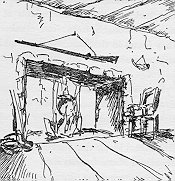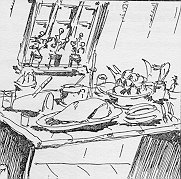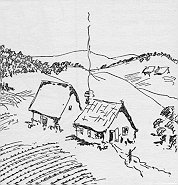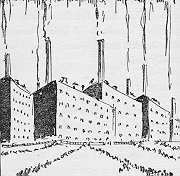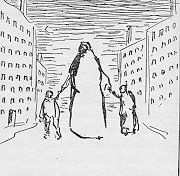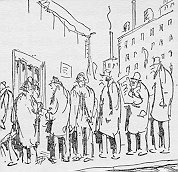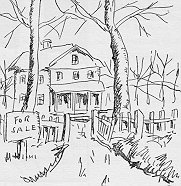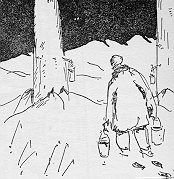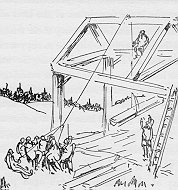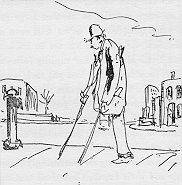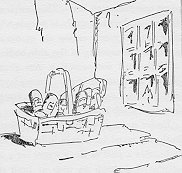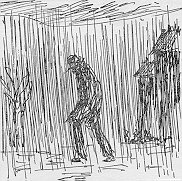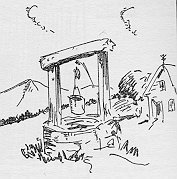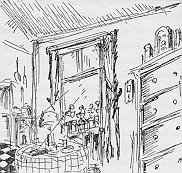Why Social Security?
This 32-page Social Security Board booklet was published in 1937 as part of the Board's efforts to educate the American public about the rationale underlying the new Social Security program.
Why Social Security?
| "SECURITY was attained in the earlier days through the interdependence of members of families upon each other and of the families within a small community upon each other. The complexities of great communities and of organized industry make less real these simple means of security. Therefore, we are compelled to employ the active interest of the Nation as a whole through government in order to encourage a greater security for each individual who composes it.... This seeking for a greater measure of welfare and happiness does not indicate a change in values. It is rather a return to values lost in the course of our economic development and expansion." Franklin D. Roosevelt: Message of the President to Congress, June 8, 1934. |
This brief account of the development of measures for social security was written by Mary Ross of the Bureau of Research and Statistics, of which Ewan Clague is acting director.
The pamphlet was illustrated by Hendrik Willem Van Loon to express his own personal interest in the development of social security in the United States.
SOCIAL SECURITY BOARD, WASHINGTON, D. C.
PUBLICATION NO. 15
|
WHY SOCIAL SECURITY? THE MUSKET hung over the fireplace once stood for security in American homes. It meant game for the pot. It gave protection against unfriendly beasts and Indians. It was a first defense against hunger and danger in the new land. Probably no families in the world ever have been as self-reliant as the Americans who wielded their muskets in the Colonies and on the frontier. They literally made their own living, for a family had little or nothing except what their members could do and make. A large family was an advantage, since then there were many hands to plant and weed and harvest, to chop wood, to carpenter, to spin and dye and weave, cook and sew. A widow with children was a matrimonial prize. |
| For the colonists a musket was a symbol of a home's security |
Our Thanksgiving celebrates the security of the colonists. Our turkeys are the descendants of the wild turkeys their muskets brought down; our cranberries, of the cranberries they found in the bogs. Our pumpkins, potatoes, and onions still commemorate the good harvest the Pilgrims gathered in 1623.
|
For 250 years and more many American families, like the first colonists, measured their security in terms of the things they could make and do for themselves. As the frontier stretched westward, covered wagons carried with them the habits and ideals that had conquered the wilderness at Jamestown and Massachusetts Bay. Now automobiles plunge in days over the trails that a scout on horseback or a wagon could travel only in months, and airplanes cross the continent in a single hop. The ways in which American families live have changed as swiftly as the ways in which they travel. |
| Thanksgiving still commemorates the pioneers' security |
Within the lifetime of people still living, the frontier has all but vanished. Change is so obvious that we are likely to take it for granted. It has come so quickly that it is hard to realize what it means to us who live today.
In the following pages, print and pictures outline some of the changes that have brought us to days when we reach for a pay envelope, not a musket, to get our food and protect our homes.
WORK MOVES TO THE CITY
As late as 1890 more than a third of the Nation's homes were on farms. Country families are bigger than city families. Hence it was not until 1920 that the census found a greater number of people in the towns and cities than on farms and in villages. Today the farms have only about a fifth of the homes and less than a quarter of the population. In hardly more than a generation we have ceased to be predominantly a nation of country people.
Boys and girls left the farms because the road of opportunity led to the city. Not so many hands were needed on the farms. Machines were taking over work that muscles once had done. Science taught more efficient ways to use the land. Up to 1870 the farms had more than half the Nation's workers, not counting children. By 1930 they had only one in five.
Farm efficiency has grown especially rapidly in recent years. Production per acre increased nearly 20 percent between 1910 and 1930. Production per worker increased 40 percent.
|
Young people from the farms went into the factories and mines. They helped build the railroads and the cities. There seemed no end to new jobs in the rapidly developing Nation. From 1870 up to 1910 each census found a larger percentage of the population "gainfully occupied." As factories turned out more goods, more people were needed to sell them and to finance the making and selling. Since 1900 literally millions of men and women have found jobs in these fields--as salespeople, stenographers, and clerks, telephone and telegraph operators, wholesale and retail dealers, bookkeepers, cashiers and accountants, insurance agents, commercial travelers, stockbrokers, and bankers. |
| For generations, with plow, kettle, and loom, we made our living |
And as invention and science multiplied the output of one field after another, more of our energy could be turned into jobs which have to do with services, rather than things. There has been a growing number of restaurant and lunchroom keepers, janitors and elevator operators, barbers and manicurists, doctors, dentists, and trained nurses; of librarians, teachers, and other public servants; actors, authors, and artists; lawyers, chemists, and technical engineers.
Some of these added jobs represent services which families formerly had done for themselves at home. Others reflect our rising standards of living--more and better education, better health, more leisure, greater comfort and convenience in daily living.
MAKING A LIVING AND MAKING MONEY
The life in all these many occupations differs in one way from that of the farms where once most Americans made their living.
Today we do not make a living. We buy it. We make money, and that money mostly determines the kinds of houses we live in, the food we eat and the clothes we wear, the security and independence we look to in hard times, sickness, and old age.
Even in the Colonies, of course, some things were bought and sold. Paul Revere was a silversmith as well as a soldier. But the colonists used money chiefly to buy the luxuries of those days, such as Paul Revere's porringers, or fine furniture, or tea, coffee, and spices.
Many Americans lived as did a New England farmer who wrote in his diary:
"My farm gave me and my whole family a good living on the produce of it and left me, one year and another, one hundred and fifty dollars, for I never spent more than ten dollars a year, which was for salt, nails, and the like. Nothing to eat, drink, or wear was bought, as my farm produced it all."
|
On the farms of our grandparents where soap and candles were made and hogs butchered for the smokehouse, a family still made a considerable part of their living without using money. Even today, an important part of the "income" of farm families comes in the things they raise and make for themselves. But farmers, too, now must have money. They need it for the kinds of things we no longer make at home and also for the modern tools of their trade--for machines and gas and oil to run them with, for commercial fertilizers, for radios to follow weather and market reports. |
| Today most families must buy, rather than make, their living |
In the towns and cities, money is the means of existence from day to day.
The home of a pioneer family was a little world in itself. Members of the family were their own farm and factory workers, butchers, bakers, and barbers; policemen and firemen; often their own doctors and nurses, and sometimes their own teachers as well.
As one of these occupations after another has gone out from under a family's roof, it has become possible for us to have more goods and services than a family can produce for themselves. But most of a family's chance to have them depends on their ability to buy a living.
A FAMILY NO LONGER IS A FIRM
It is common to hear young people discussing when they can afford to marry and have children. That question would have astonished young people on the frontier.
A young man then could hardly afford not to marry. He needed a wife as a business partner, children as helpers. In early New England not only spinsters but bachelors were under a cloud. Bachelors, in fact, were regarded with suspicion. Usually they had to live where the court told them to. Single people had to attach themselves to a family to get a chance to work for their living.
Both the children and the old people earned their place at the family table.
As we have shifted from a land economy to a money economy, the work of the young and the old no longer has the same value in helping a family to make their living.
Children need more schooling. Once they learned from their chores, while doing the family's business, many of the things they needed to know as adults. Now work at home fails to give them the background they need for jobs in business, trades, and professions. State by State, we agreed that children must go to school.
Change in the work done at home and in our knowledge and standards of child care made children almost a luxury to a family, instead of an economic asset. Families are smaller, especially in the cities. There are fewer sons and daughters to care for the old people of future years.
|
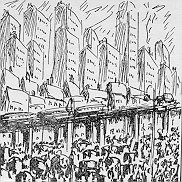 |
|
| Cities have little room for useful work of the young and old | The work of women shifted to offices, mills, and factories |
Old people, like children, have lost much of their economic value to a household. Most American families no longer live in houses where one can build on a room or a wing to shelter aging parents and aunts and uncles and cousins. They no longer have gardens, sewing rooms, and big kitchens where old people can help make the family's living.
Old people were not "dependent" upon their relatives when there was need in a household for work they could do. They have become dependent since their room and their board cost money, while they have little to give in return. Now they need money of their own to keep the dignity and independence they had when their share in work was the equivalent in money.
The shift of work away from homes also explains the work of girls and women today. Women have always worked for their living. When work left the home, they followed it into factories and offices. By 1930 the census found a quarter of all the girls and women "gainfully occupied", not including housewives working without pay for their families.
Studies of employed women have shown again and again that they, like men, get jobs in order to support themselves and their families. In other words, they, too, have shifted from making a living to making money. It is among native-born white American women that the habit of wage work has grown up so rapidly.
Married women, like single women, find it necessary to work for wages. Between 1900 and 1930 the percentage of married women at gainful work increased six times as rapidly as that of single women of the same ages. Many married women carry the double job of housewife and wage earner. Here again, studies show that they do it because their families need their money.
Most of the work of wage-earning women represents not women's rights but women's duties.
During our lifetime it has become increasingly difficult for a family to pull together and go into business for themselves in one way or another.
For years there was good land to the westward to be had for the taking. Homesteading was an outlet for the sturdy and ambitious. In the towns, family shops and businesses were carried on with relatively small amounts of capital.
There is no more free land on which a living can be made. A farmer needs machines as well as skill and grit if he is to compete in the market. In the towns and cities, modern methods of production and merchandising have greatly increased the experience and capital needed to go into business and stay in business.
Individual enterprise, which so often meant family enterprise, now plays a minor part in earning our national income. Including the farmers, only about one in five of the gainfully occupied works for himself. As a nation, we no longer work as individuals or families, but as employees.
LIFE IS SAFER, BUT LIVING LESS SECURE
The safety of life has never increased as rapidly at any time on record as in the past 40 years.
Take Massachusetts, for example, where there are records over a long period. A baby born in Massachusetts in 1789 had, on the average, an expectation of a life of about 35 years. In the next century the expectation of life at birth increased about 8 years; babies born in Massachusetts in 1890 had before them a life expectation of 42.5 years for men and 44.4 years for women. But between 1890 and 1930 those averages grew to more than 59 years for men and more than 62.5 for women.
|
The gain in the 40 years following 1890 was twice as great as that of the whole century preceding. This gain in average length of life has come almost wholly from success in saving the lives of babies, children, and young people. More of us live to reach middle age and old age. At the same time the birth rate has been declining. The result of these changes is that old people form an increasing percentage of the population. |
| We are employees. Life is safer, but living is insecure |
While life became safer, the chance to earn a living became less secure. The growth of employment in basic industries began to slow up. Machines and improved methods made it possible to increase output without increasing the number of workers needed to produce it. Then, for the first time, one important field of work after another reached its peak in employment and began to decline--began to use a smaller number of workers.
Agriculture's share in the total employment of the Nation had been going down since 1870 but each census up through 1910 counted a larger number of agricultural workers. In the census of 1920 and the census of 1930 the number of workers was smaller. In 1930 there were 600,000 fewer farmers and farm workers than there had been 20 years before.
A similar change came in mining. Efficiency was growing. In 1930 two soft-coal miners could turn out as much as three had done in 1900. The peak in the census record of mine workers came in 1920. In the 10 years that followed, industrial activity was expanding, and new mine workers were needed for the gas wells and oil wells. But by 1930 the total number of miners had dropped by 100,000.
All through the prosperous years of the 1920's there were fewer workers on the pay rolls of factories and steam railroads than there had been at the start of the decade. In 1930 the average number of factory workers was 1,500,000 less than that of 1920. The average number of employees of steam railroads had dropped by 500,000.
A man no longer had the same chance to continue through his working years in the occupation he had learned as a boy. The new openings in trade and the service occupations and professions often made specialized demands which workers from the older industries found it hard to meet. It was not likely to help a jobless miner, for example, to learn that more barbers were being employed.
This shift in occupations was particularly difficult for older men. From 1890 on, an increasing percentage of the men of 65 and over has been reported as unoccupied.
With the census of 1920 a more general change appeared. In that year and in 1930 the reports showed a drop in the percentage of all men and boys of 16 and over in gainful occupations. In spite of the increasing employment of girls and women, these reports found a decline in the proportion of all Americans of 16 and over in gainful occupations.
|
Work has been shifting from place to place as well as from occupation to occupation. Manufacturing was declining in New England, for example, at the time when the growing automobile industry pushed it upward in the Central States. Often families must move to follow jobs or find them. Americans always have moved in search of a living. The older migrations, however, were likely to be those of people who expected to found a new home, settle down, and grow up with the town. The quick shifts of recent years have split up families. They have weakened the old ties of kinship and neighborliness on which a family used to rely. The loss of neighborliness and the increasing size of stores and factories have weakened the personal ties between workers and their employers. |
| Industries shift and families move to find jobs or follow them |
|
As work has become specialized, we also have developed occupations in which the demand for work shifts from season to season. On family farms work was, and is, seasonal in the sense that each season has its particular demands. But indoors and outdoors, there is something useful to be done each month of the year. The season for wood-cutting comes when the fields are bare; for sewing, before or after pantry shelves are stocked with jellies and preserves. |
| On family farms each month in turn brings its own occupation |
But when factories began to turn out the clothing that families had made during the spring and the fall sewing, factory workers entered jobs in which they were likely to be employed for only part of the year. A cutter or a machine operator may be an expert at his own job, but he finds it is hard to earn in some other way when the factory slows down or closes.
All these changes in the kinds and places and time of work have made the demand for workers changeable and uneven.
As a result, many workers--especially industrial workers--were without jobs even in boom times.
The Committee on Economic Security found that in the years 1922-29 an average of 8 percent of our industrial workers were unemployed. In the best of those years, nearly 1,500,000, on the average, were without jobs.
When hard times came, further millions lost their chance to earn a living. By 1932 and 1933 industrial unemployment had risen to about 39 percent. That meant two industrial workers out of five--10,000,000 or more in all.
The word "unemployment" was not used in English dictionaries before 1888. "Unemployable" came into use only a year earlier.
As far as we can look back, men and women, of course, had lost one way of earning their living and had to find others. Groups of workers, like the hand weavers, had seen their work taken away by machines. But it is only recently that we have realized that there could be a widespread situation-- even in good times--in which large numbers of people who needed to work and wanted to work had no chance to do so.
It was not until machines had knit our lives closely together in industry and trade that unemployment could weigh down families throughout a community or a nation. Only recently have we realized that the requirements of work have become so specialized and exacting that at any one time some people cannot hold any paid job.
In our present money economy, unemployment has become a common hazard of family life like the epidemics which swept our cities three or four generations ago. A family's livelihood can be cut off as quickly and unexpectedly as their lives once were cut off by typhus, yellow fever, or cholera.
Unemployment is like a contagion also because it spreads. When a big factory shuts down, its whole neighborhood and city suffers. The livelihood of all who have been selling their goods and services to those wage earners is affected--storekeepers, landlords, doctors, barbers, owners of movie houses, and, in turn, the workers whom they employ and those who produce the goods they sell. When large numbers of people in one part of the country are without earnings, families on farms and in cities hundreds of miles away may find their living less secure.
Science and invention have given ordinary people ease and comfort and variety of which even rich people of earlier civilizations did not dream. A pair of silk stockings once was a present for a king or queen. But this progress has a price. It demands that we use our ingenuity to keep families independent, now that their living hinges on the judgment, skill, and good luck of many other people as well as of themselves. We have shown our ingenuity in making machines and scientific discoveries. The job now is to adapt our common life to the changes that came with our progress.
FAMILY SECURITY AND SOCIAL SECURITY
The words "social security" have become popular in the last five or ten years. Actually the right and duty of a community to protect its members is as old as the records of men. Primitive tribes have rules and customs to assure the safety of all.
Even pioneer American families, of course, relied on each other for help in trouble and emergencies. Barn-raisings and corn-huskings, which have lasted down to our times, are a survival of years when a household asked the neighbors' help in an emergency, knowing it would give its help when its turn came.
|
But communities did not rely wholly upon the willingness of people to help each other. They did not rely wholly even on the willingness of families to support their own members. The common law of England, for example, lays down the duties husbands and wives owe to family support. Under later circumstances we have found many of the older family laws oppressive, such as the laws which restricted the right of a woman to her earnings, or her right to hold or will property, or to make decisions about her children. Those laws, however, were intended for the protection of families under the circumstances in which they lived when the laws were made. They held a family together as an economic unit. |
| Neighbors always have banded together to help in emergencies |
The great English commentator, Blackstone, wrote: ". . .even the disabilities which the wife lies under are for the most part intended for her protection and benefit. So great a favorite is the female sex of the laws of England."
In the Colonies, drawing their traditions from England, a husband was obliged by law to support his wife in the manner justified by his circumstances. He was liable for the debts she had contracted before her marriage, as well as later ones. She had a right to inherit part of his estate when he died. In these ways, law and custom, as well as affection, protected the security of persons least able to get security for themselves.
Since a living was made in families, it was through families that a community made and enforced its security measures.
Many of these measures remain with us today. The security of children, wives, and aged parents does not depend upon the willingness of their relatives to support them. It is written into our laws and enforced daily in our courts. It is a form of social security because we see to it as a society that relatives give this support when they can, whether they wish to or not.
SECURITY IN HEALTH AND SAFETY
As cities have grown up we have taken another series of steps for social security by banding together to pay for certain kinds of protection that no one family can provide for themselves. We have police and fire departments, for example. We make fire laws governing the kinds of buildings that people may build in safety to themselves and their neighbors. We support public-health departments. We set up traffic regulations to protect safety of life on the highways and streets.
We also have taken steps to aid helpless people who need a kind of care or an amount of protection that few families can provide for themselves. As our increasing scientific knowledge showed the need and the way, we built hospitals for the mentally sick and for people with tuberculosis. We made laws and opened clinics and special schools for crippled children.
At first these measures to help unfortunate people dealt chiefly with those who were dangerous to others, such as mental patients and people sick with communicable diseases. More recently we realized that it is public economy as well as kindness to make sure that other disabled people get care, since often they can recover enough to earn a living for themselves. It is cheaper to cure them than to care for them for years in institutions.
About forty years ago we began to realize that security in health and life must follow people out of their homes and into the factories.
Our greatest success has come in making life safe for children.
Up to about 1900 many children had gone along with their elders into the factories. In 1900 nearly a fifth of all the 10-to-16-year-old children were at work. This was a larger percentage than had been found in any previous census year.
Then State after State decided that factories were not places for children. Laws were passed to restrict child labor and to specify the conditions under which children might work, if at all. At the same time other laws made it compulsory for children to have more chance to go to school and stay in school. In 1930 less than one-twentieth of the 10-to-16-year-old children were in gainful work.
We have not yet lifted by any means all the burden of harmful labor from the shoulders of children, but most of it is gone. And in the twentieth century we have come far toward achieving what some of the colonists set themselves as a goal: the right of children to the security of an education. In 1932 President Hoover's Committee on Recent Social Trends declared that the fact that half the children of high school age were in the high schools was "evidence of the most successful single effort which government in the United States has ever put forth."
In the past forty years many States have passed laws to promote health and safety in work for adults as well as for children--laws governing hours of work, night work, dangerous work, and the like. These are conditions which workers no longer can control for themselves as they could when they worked at home.
SECURITY OF LIVELIHOOD
And in some ways we have taken steps toward assuring not only health and safety in work but also the money to which working families must look in order to buy their living.
When children were taken out of factories and put in school, it was obvious that some families suffered from the loss of the children's earnings. This was especially true in families where the father was incapacitated or dead. Widows with children were no longer a matrimonial prize.
In 1911 two States passed laws to give small money allowances to needy mothers, so that they could keep their children at home rather than put them in an institution. By 1930, 44 States and the District of Columbia had mothers'-aid laws on their books. Upward of 200,000 children were being aided.
|
Other laws looked to the earnings of adults. By 1911 a majority of the States had passed laws establishing minimum wages for employees on public works. By 1910, 10 percent of the States had established free public employment services--a measure later adopted by a majority of States. In that same year, 1910, New York State passed the first workmen's compensation act, followed in the next twenty years by all but four of the remaining States. These laws required employers to insure their employees against injury. Under them the cost of industrial accidents, and to some extent the costs of sickness due to work, have become a part of the running costs of industry. |
| The States began to require compensation for injured workers |
Under the old common law injured workers had a right to try to collect damages from their employers. The workmen's compensation acts established a more just and orderly way to give workers what the common law admitted as their due.
In the past twenty years many States have taken steps to give some security to another large group of their people--the old people who never will earn again. Arizona passed the first old-age pension act in 1914. After the World War one State after another rapidly followed suit. By the end of 1930 fourteen others had put such laws on their statute books, and in the next three years ten more were added.
This wave of laws to pay regular allowances to needy old people did not come by accident or imitation. It came because of the growing percentage of old people in the population and the inability of the old to work for their living. Old age was becoming an increasingly serious problem to old people and their families and their towns and counties.
Most of the allowances given to old people under State laws have been very small. Even so, they have helped many old people to stay in their own homes and to keep their self-respect when they share the homes of others. Giving allowances has been cheaper as well as more humane than caring for old people in poorhouses.
Mothers' aid and old-age allowances are not "pensions" in the sense in which we usually use that word. Widowed mothers and old people do not get assistance just because they are widowed or have reached a certain age. They also must show that they are in need.
Regular allowances have not been given to all the needy aged and needy mothers even in States where there have been such laws. Under some of the State laws a county chose whether or not it wished to operate under the State plan. When county and State funds ran low, even eligible applicants remained on waiting lists for months or years.
|
Mothers' aid and old-age assistance are a modern way of giving what we used to call charity. They are relief measures. They recognize the responsibility of counties and States to give security to people who cannot earn it for themselves and provide a more just and orderly way to meet that responsibility. They are better methods than those which States and towns and counties long have used, such as giving baskets of food or tons of coal, or building orphanages and almshouses. They give the people they help a greater chance to choose how they will live. They provide them with what all of us now use to keep our freedom and self-respect. They give them money. |
| A basket of groceries does not solve the problems of the poor |
One social historian has called measures like these social inventions. They are ways we have invented to fit our social life to the changes brought by mechanical and scientific inventions.
Nearly five years ago one State made a social invention which never before had been used in the United States. In January 1932 Wisconsin passed the first American unemployment compensation law. This law is unlike those mentioned above. It does not apply to people who cannot work because they are too young or too old or too sick. Its purpose is to promote the security of the able-bodied.
Workmen's compensation acts protect workers from the costs of accidents at work. Unemployment compensation acts protect them against some of the costs of the accident of not having any job at all.
Under unemployment compensation, pay rolls or wages or both are taxed in certain industries to pay workers in those industries a part of their wages for a time while they are un-employed through no wish or fault of their own. In some countries these payments are supplemented by governmental grants from general taxation.
The tax borne by employers is a charge on industry, like other costs of doing business. When workers also are taxed, their payments are like premiums paid for fire insurance or accident insurance. The many people who run a risk pay toward meeting the loss of those on whom catastrophe falls. The lucky help pay for the unlucky. It is worth their while to do so, for they do not know when catastrophe may hit themselves.
Under the systems of unemployment compensation so far established in the United States, unemployed workers still carry a large part of the loss of being without jobs. Unemployment benefits usually do not begin until a man has been out of work for several weeks. They provide only a part of the amount he would have earned. They cease after a limited period, even though he still has not found another job.
Benefits paid to unemployed workers cushion the shock of losing a job, especially in short-time unemployment, which is the most usual type of unemployment in ordinary times. They make it possible for workers to keep on buying their living while they are looking for other work. In that way, these payments also benefit all those with whom these workers ordinarily deal.
Unemployment compensation is not charity or relief but a means of preventing need for relief. Through unemployment insurance, like other types of insurance, a loss which is crushing to those who incur it in any one month or year is made bearable by being distributed over large numbers of people and over a period of time.
SAVING FOR A RAINY DAY
Our expression "saving for a rainy day" recalls the times when families stored wood in the shed and food in the cellar and pantry for seasons when it was difficult or impossible to go out to fetch them. Why do they not store money in the bank now for the time of unemployment or old age when it cannot be made?
There is an answer to that question in a study made by The Brookings Institution, which analyzes the incomes and savings of families in our richest year, 1929.
In that year, the study found, families with incomes under $1,000 spent, on the average, more than they received. They drew on past savings or got outside help or went into debt. Those families with incomes of less than $1,000 represented a fifth of all the families of the Nation in 1929.
Families with incomes of $1,000 to $1,500 kept even, on the average, but saved little, especially in the cities where everything had to be bought and living costs were higher. These families represented another fifth of all the families in that year.
Thus the study found that about 40 percent of our families saved very little, as a group, in our richest year for the hard times that were coming.
Practically all the savings of that prosperous year were made by the families at the top of the money ladder.
About 10 percent of us had family incomes over $4,600. They were found to have made 86 percent of all the savings.
Another 10 percent had family incomes of $3,100 to $4,600. They were found to have made 12 percent of all the savings.
The great majority of American families--the 80 percent who had incomes under $3,100 in 1929--were found by that study to have saved only 2 percent of all that families saved that year.
Could the 80 percent have saved more than they did?
The Brookings study declared that at 1929 prices a family income of $2,000 "may perhaps be regarded as sufficient to supply only basic necessities." An income of $2,500 was "a very moderate one."
Even low income families today are likely to regard as necessities things which their parents may have done without, such as running water, electricity, haircuts, movies, a greater variety in clothing and diet. It costs more to be sick. Medical care is better and, hence, more expensive. An employee who loses time from his job because of sickness often loses pay and sometimes loses the job as well.
But what would be the result if all families did save as much as they could by doing without all but the barest necessities?
|
The families who now save little--those with low and moderate incomes--make up a large share of the markets on which our living depends. In 1929, 70 percent of all the families were under the $2,500 mark which the Brookings study defined as "moderate." The spending of that 70 percent is necessary to hold up the fabric of trade and industry on which the living of the Nation depends. When a large part of the population cuts down spending, that fabric sags, and workers and others feel the weight of hard times. That is what happened in the early years of the depression when fear and necessity made people stop buying. |
| Rainy-day savings are not an adequate safeguard for the jobless |
There seems no question of the willingness of American families to save when their incomes approach a comfortable level. But the evidence of this study shows that most families, and especially the families whose risks are greatest, have little to look to when a rainy day comes. Their security lies in the steadiness of their earning and the safety of what savings they are able to make for the years when they no longer can earn.
|
When trade and industry gathered homes into closely built-up towns and cities, it no longer was safe for each house to have its own well. The safety of the whole town made it necessary to have a town water supply. The safety of all of us now depends also on the general streams of earning and spending. Unless many families are buying--are paying money into a common pool by their spending--the stream of earnings is lowered, and all have less chance to earn. The well-being of country families and city families depends on the ability of other families to buy. |
| Modern communities cannot safely follow customs of the past |
The security of families has followed their work out of the homes. Social security no longer is homemade.
THE SOCIAL SECURITY ACT OF 1935
The Social Security Act of 1935 grows out of these many changes in American life. It consolidates our past experience in meeting insecurity. It also sets up a bulwark against some of the newer kinds of insecurity that threaten large numbers of us in this twentieth century.
Several parts of the Social Security Act deal with groups of people whose troubles we have recognized for many years. These provisions consider the people who are too young or too old to earn or are physically handicapped. The act authorizes Federal grants-in-aid to enable the States to broaden and extend regular allowances for needy mothers, the needy blind, and the needy aged. It authorizes grants-in-aid for State services for child welfare, for crippled children, and for physically handicapped people who can be helped to work again. The provisions for child welfare apply especially to rural areas.
These sections of the Social Security Act draw on our national resources to help all States to do better what most or all have undertaken in some way and to some degree. They give a way to put into effect the best measures we have been able to devise for helping people who are unable to help themselves.
Other provisions of the Social Security Act recognize the risks of sickness--risks which affect all of us, young and old, rich and poor. The act authorizes Federal grants-in-aid to help States to give service for the health of mothers and children and to strengthen and extend public-health services. It authorizes funds for the study of national and interstate health problems. These parts of the act promote security by preventing sickness and by giving children, especially country children, a fair start in life.
Finally, two provisions deal with insecurity in earning. They apply to groups of our people who have moved into occupations where earning often is risky. They cover a great share of the wage earners who are wholly dependent on their ability to buy a living.
Under one of these provisions, the Social Security Act sets up a framework to protect the States which wish to enact laws for unemployment compensation. Federal funds are authorized to help a State to do this by meeting the costs of administration.
The Social Security Act does not say that any State must have an unemployment compensation law. It does not say what kind of law a State should have. It does say that business in a State which has unemployment compensation shall not be penalized in competition with business in States which do not.
From the beginning of 1935, when the possibility of harmony in State action became clear during the discussion of the Social Security Act in Congress, and up to April 1, 1937, 42 States and the District of Columbia had enacted unemployment compensation laws. These laws are a beginning in making the costs of industry's fluctuations a charge upon industry rather than only on the jobless workers, who hitherto have borne the brunt of industrial change.
The act thus helps States to find ways in which workers and employers can steady livelihood. It also provides ways to build up the livelihood of wage earners in old age.
The Social Security Act establishes a system of Federal old-age benefits which will provide monthly payments, in 1942 and after, to many workers when they reach the age of 65. The amount of a man's benefit depends on the wages he has received in his working years, after 1936, as defined in the act. Thus old-age benefits are based on wage records.
Under another provision of the act grants are made to the States for old-age assistance. Old-age assistance is not the same as old-age benefits. In old-age assistance Federal, State, and local funds are used to help old people who lack means of their own. Regular assistance may be given to any aged person who is entitled to aid under a State plan approved by the Social Security Board. Thus old-age assistance is helping those who now are old and in need.
Old-age benefits, on the other hand, offer future provision for large groups of people who now are working and earning. Under the plan for old-age benefits, the majority of the Nation's wage earners can look forward to a definite old-age income of their own. Their old-age benefits will supplement any savings these workers have been able to make. They do not have to prove that they are needy. The benefits are theirs regardless of need.
If a worker dies before he has received his benefits, his estate receives a lump sum equal to 3 1/2 percent of his wages counted toward benefits.
In general, the Social Security Act helps to assure some income to people who cannot earn and to steady the income of millions of wage earners during their working years and their old age. In one way and another taxation is spread over large groups of people to carry the cost of giving some security to those who are unfortunate or incapacitated at any one time. The act is a foundation on which we have begun to build security as States and as a people, against the risks which families cannot meet one by one.
The colonists and frontiersmen wanted independence. They wanted a chance for themselves and their children.
|
They wanted a place of their own and an active share in the life of their times. There is no reason to think that our wants have changed. These are the things that most Americans ask today. What has changed is the way we take to get them. Families no longer can carve out security for themselves. Our security is the security of a people. |
| Today's families, like the colonists', want a place of their own |
Facts cited in this pamphlet are drawn from the reports of the U. S. Bureau of the Census and frown other authoritative governmental and non-governmental reports, including reports of the White House Conference on Child Health and Protection (1930); Recent Social Trends in the United States (1933); America's Capacity to Consume (Brookings Institution, 1934); and Report to the President of the Committee on Economic Security (1935).
INFORMATION
Information concerning the several sections of the Social Security Act may be obtained from the following Government agencies:
Old-age assistance, aid to dependent children, and aid to the blind; unemployment compensation; old-age benefits; Titles I, II, III, IV, VII, IX, X of the Social Security Act. INFORMATION SERVICE, SOCIAL SECURITY BOARD, WASHINGTON, D. C.
Maternal and child-health services, services for crippled children, and child-welfare services; Title V of the Social Security Act. CHILDRENS BUREAU, DEPARTMENT OF LABOR, WASHINGTON, D. C.
Public-health work; Title VI of the Social Security Act. BUREAU OF PUBLIC HEALTH SERVICE, DEPARTMENT OF THE TREASURY, WASHINGTON, D. C.
Vocational rehabilitation; Title V, Part 4, of the Social Security Act. OFFICE OF EDUCATION, DEPARTMENT OF THE INTERIOR, WASHINGTON, D. C.
All taxes levies under the Social Security Act; Titles VIII and IX. BUREAU OF INTERNAL REVENUE, DEPARTMENT OF THE TREASURY, WASHINGTON, D. C.
U.S. Government Printing Office 16-6087
